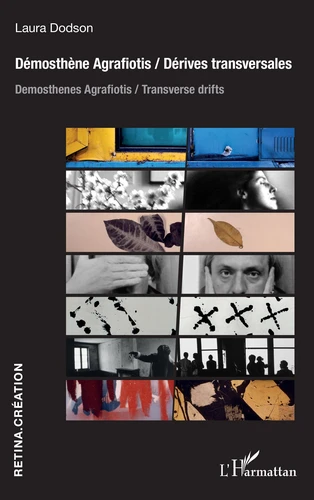Démosthène Agrafiotis / Dérives transversales. Demosthenes Agrafiotis / Transverse drifts
Par :Formats :
Disponible dans votre compte client Decitre ou Furet du Nord dès validation de votre commande. Le format PDF est :
- Compatible avec une lecture sur My Vivlio (smartphone, tablette, ordinateur)
- Compatible avec une lecture sur liseuses Vivlio
- Pour les liseuses autres que Vivlio, vous devez utiliser le logiciel Adobe Digital Edition. Non compatible avec la lecture sur les liseuses Kindle, Remarkable et Sony
 , qui est-ce ?
, qui est-ce ?Notre partenaire de plateforme de lecture numérique où vous retrouverez l'ensemble de vos ebooks gratuitement
Pour en savoir plus sur nos ebooks, consultez notre aide en ligne ici
- Nombre de pages162
- FormatPDF
- ISBN978-2-336-52381-1
- EAN9782336523811
- Date de parution10/04/2025
- Copier Coller01 page(s) autorisée(s)
- Protection num.Digital Watermarking
- Taille68 Mo
- ÉditeurL'Harmattan
Résumé
L'intérêt de Démosthène Agrafiotis pour la photographie était né dès le milieu des années soixante et avait en fait précédé à la fois sa poésie et sa peinture. Ayant maîtrisé la technique photographique, il a immédiatement commencé à explorer les possibilités expressives de la photographie, se créant ainsi une passerelle vers les autres arts. Lorsqu'il a commencé à écrire de la poésie à l'âge de 23 ans et commencé à peindre quelques années plus tard, il était ravi de constater que chaque art séparé, tout en conservant ses traits intrinsèques et son individualité, possédait néanmoins des caractéristiques latentes des formes des arts voisins.
Parfois, il pouvait trouver les racines de la peinture dans sa photographie, et d'autres fois une approche photographique de sa poésie. Demosthenes Agrafiotis' interest in photography commenced as early as the mid-sixties, preceding, in fact, both his poetry and his painting. He immediately began to explore the expressive possibilities of photography, thereby creating for himself a gateway into the other arts.
When he began writing poetry at the age of 23, and when he started painting a few years later, he was delighted to find that each separate art, while maintaining its intrinsic traits and individuality, nevertheless possessed latent characteristics of its neighbouring art forms. At times he could find the roots of painting in his photography, at others a photographic approach to his poetry.
Parfois, il pouvait trouver les racines de la peinture dans sa photographie, et d'autres fois une approche photographique de sa poésie. Demosthenes Agrafiotis' interest in photography commenced as early as the mid-sixties, preceding, in fact, both his poetry and his painting. He immediately began to explore the expressive possibilities of photography, thereby creating for himself a gateway into the other arts.
When he began writing poetry at the age of 23, and when he started painting a few years later, he was delighted to find that each separate art, while maintaining its intrinsic traits and individuality, nevertheless possessed latent characteristics of its neighbouring art forms. At times he could find the roots of painting in his photography, at others a photographic approach to his poetry.
L'intérêt de Démosthène Agrafiotis pour la photographie était né dès le milieu des années soixante et avait en fait précédé à la fois sa poésie et sa peinture. Ayant maîtrisé la technique photographique, il a immédiatement commencé à explorer les possibilités expressives de la photographie, se créant ainsi une passerelle vers les autres arts. Lorsqu'il a commencé à écrire de la poésie à l'âge de 23 ans et commencé à peindre quelques années plus tard, il était ravi de constater que chaque art séparé, tout en conservant ses traits intrinsèques et son individualité, possédait néanmoins des caractéristiques latentes des formes des arts voisins.
Parfois, il pouvait trouver les racines de la peinture dans sa photographie, et d'autres fois une approche photographique de sa poésie. Demosthenes Agrafiotis' interest in photography commenced as early as the mid-sixties, preceding, in fact, both his poetry and his painting. He immediately began to explore the expressive possibilities of photography, thereby creating for himself a gateway into the other arts.
When he began writing poetry at the age of 23, and when he started painting a few years later, he was delighted to find that each separate art, while maintaining its intrinsic traits and individuality, nevertheless possessed latent characteristics of its neighbouring art forms. At times he could find the roots of painting in his photography, at others a photographic approach to his poetry.
Parfois, il pouvait trouver les racines de la peinture dans sa photographie, et d'autres fois une approche photographique de sa poésie. Demosthenes Agrafiotis' interest in photography commenced as early as the mid-sixties, preceding, in fact, both his poetry and his painting. He immediately began to explore the expressive possibilities of photography, thereby creating for himself a gateway into the other arts.
When he began writing poetry at the age of 23, and when he started painting a few years later, he was delighted to find that each separate art, while maintaining its intrinsic traits and individuality, nevertheless possessed latent characteristics of its neighbouring art forms. At times he could find the roots of painting in his photography, at others a photographic approach to his poetry.




